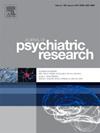Feasibility of digital monitoring in patients receiving ambulatory psychiatric care
IF 3.2
2区 医学
Q1 PSYCHIATRY
引用次数: 0
Abstract
Objective
Monitoring the course of mental disorders in patients receiving ambulatory care may help improve their outcome and reduce complications. For this purpose, smartphone based digital monitoring has been suggested as an effective approach. However, few data exist regarding its feasibility in real-world. In this naturalistic study, we investigated the feasibility of digital monitoring in patients receiving routine ambulatory care and its clinical determinants.
Methods
The clinical characteristics of patients were collected from the electronic clinical records. They included age, gender, diagnosis according to the International Statistical Classification of Diseases and Related Health Problems 10th criteria, and the measurement of severity according to the Clinical Global Impression-Severity scale. Engagement with digital monitoring at baseline was assessed by measuring the installation rate of the eB2 MindCare application on smartphones. The retention time in the digital monitoring (i.e., time until uninstallation and duration of use) was assessed over a 90-day follow-up period.
Results
Among the 212 patients involved in the ambulatory routine clinical follow-up, 148 installed the eB2 MindCare application on their smartphone. Most patients (82.5 %) were retained in the digital monitoring over the 90 days follow-up period. The engagement in the digital monitoring at baseline did not depend upon the clinical characteristics of patients (including age, gender, diagnosis or severity). The overall retention in the digital monitoring was not affected by those clinical characteristics. A diagnosis of impulsive disorder was associated with earlier interruption of the digital monitoring only during the first 90-day period.
Conclusion
Clinical characteristics do not influence engagement in digital monitoring or overall retention. Meanwhile, the diagnosis of impulsive disorders is related with earlier interruption of digital monitoring over the first 3 months. Hence, digital monitoring should be adapted for patients with impulsive disorders to increase their participation and improve their outcome.
精神科门诊病人数字化监护的可行性
目的监测门诊精神障碍患者的病程,有助于改善其预后,减少并发症。为此,基于智能手机的数字监测被认为是一种有效的方法。然而,关于其在现实世界中的可行性的数据很少。在这项自然主义的研究中,我们调查了在接受常规门诊护理的患者中进行数字监测的可行性及其临床决定因素。方法从电子病历中收集患者的临床特征。他们包括年龄、性别、根据国际疾病和相关健康问题统计分类第10条标准的诊断,以及根据临床总体印象严重程度量表的严重程度测量。通过测量智能手机上eB2 MindCare应用程序的安装率,评估基线时与数字监测的接触程度。在90天的随访期内评估了数字监控中的保留时间(即直到卸载的时间和使用时间)。结果参与门诊常规临床随访的212例患者中,有148例在智能手机上安装了eB2 MindCare应用程序。大多数患者(82.5%)在90天的随访期内保持数字监测。参与基线数字监测并不取决于患者的临床特征(包括年龄、性别、诊断或严重程度)。这些临床特征不影响数字监护的整体保留。冲动性障碍的诊断与数字监测的早期中断仅在前90天期间有关。结论临床特征不影响数字监护的接诊和整体保留。同时,冲动性障碍的诊断与前3个月较早中断数字监测有关。因此,数字监测应适用于冲动性障碍患者,以增加他们的参与和改善他们的结果。
本文章由计算机程序翻译,如有差异,请以英文原文为准。
求助全文
约1分钟内获得全文
求助全文
来源期刊

Journal of psychiatric research
医学-精神病学
CiteScore
7.30
自引率
2.10%
发文量
622
审稿时长
130 days
期刊介绍:
Founded in 1961 to report on the latest work in psychiatry and cognate disciplines, the Journal of Psychiatric Research is dedicated to innovative and timely studies of four important areas of research:
(1) clinical studies of all disciplines relating to psychiatric illness, as well as normal human behaviour, including biochemical, physiological, genetic, environmental, social, psychological and epidemiological factors;
(2) basic studies pertaining to psychiatry in such fields as neuropsychopharmacology, neuroendocrinology, electrophysiology, genetics, experimental psychology and epidemiology;
(3) the growing application of clinical laboratory techniques in psychiatry, including imagery and spectroscopy of the brain, molecular biology and computer sciences;
 求助内容:
求助内容: 应助结果提醒方式:
应助结果提醒方式:


